
Your Gardening How-To Guide: Holly Bushes Edition
Published: 27/03/2023 | Updated: 10/09/2023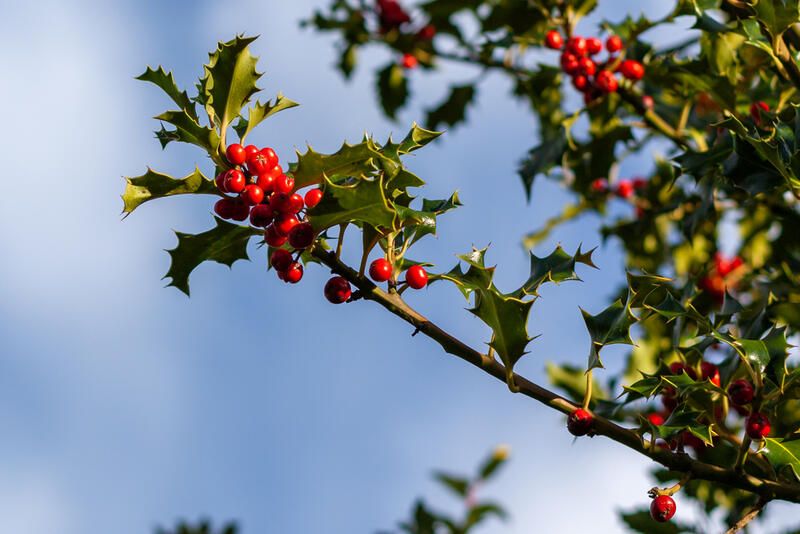
Thanks to its renowned spiked leaves and scarlet berries, Holly is the quintessential "Christmas" plant. But did you know that holly truly belongs to the Ilex genus, which contains 480 distinct species of trees and shrubs?


Also, this plant is quite "international," containing both big trees and little shrubs from all over the world.
Gardeners can plant it as a foundation, a hedge, a border, or even as a single tree or bush. Last but not least, contrary to popular belief, not all hollies are evergreen.
Ten main holly plant varieties—some deciduous, some evergreen—out of the 480 different species in the genus Ilex have found a home in general gardening.
Holly blurs the line between a tree and a shrub; certain varieties can be grown as full trees while others can be trained to resemble shrubs.
Deciduous and evergreen shrubs and trees... I understand why you can start to feel like you're lost in a forest of holly trees...
Don't worry; I'll assist you in selecting the ideal holly species for your landscape. Let's get started and I'll show you how to identify all the different hollies used in gardening and how to grow them and utilize them to their full potential in your garden!
What Are Holly Bushes:
Holly bushes (Ilex) are prickly, evergreen shrubs that occasionally have bright red berries, white flowers, and green leaves. They are a well-liked addition to winter gardens in several parts of the world because of their connection to the Christmas holiday. Yet, you can enjoy their green foliage and vivid red berries throughout the year; in fact, early spring and late fall are the finest times for them to flourish. Although they are grown worldwide, North America and Asia are home to most of the various types.
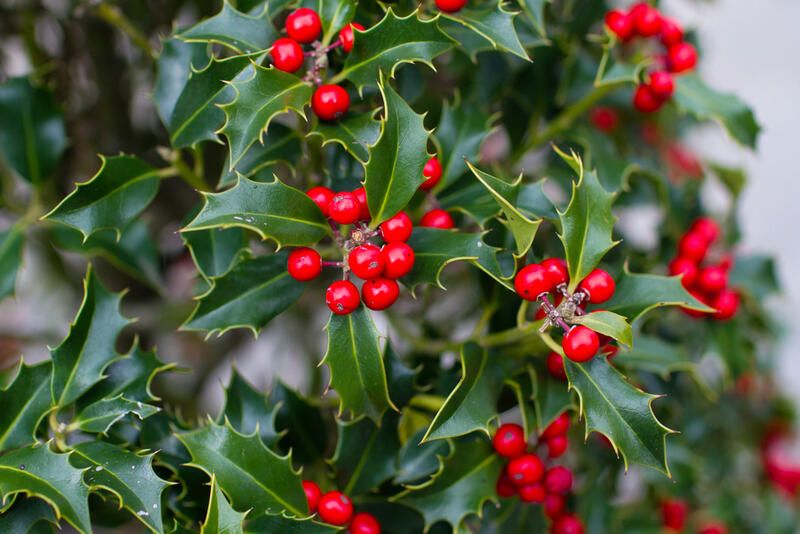
Berry Bearing Holly Shrubs vs. Trees
Let's examine the main indicators to watch out for to distinguish one holly tree from another. There are several fundamental qualities you need to remember.
Color & Size
Berry size, color, and season of ripeness. Hollies often have little, crimson fruit that ripens in the fall. However, certain other types of holly, like winterberry variants, have huge berries while others have blue, orange, or yellow berries.
Growing Habit
Forming a habit. The way that plants normally develop is in this way. By looking at its overall shape, you can determine whether the mature holly grows straight up, spreads out, or droops. Also, it provides information about the branching's thickness. For instance, most holly trees are renowned for having a fairly straight growth habit.
Leaf Shape & Color
Hue and shape of a leaf. You'll see that not all hollies have left in the traditional "Christmas decoration" shape. Some are pale green, some are elliptical, and some lack teeth or spikes.
Holly Plants to Grow in Your Garden
Holly plants come in a variety of varieties, each with its special qualities. Typical types of holly bushes are as follows:
Evergreen Shrub Hollies
Most types of garden holly are evergreen. Given that Ilex is a common Christmas card theme and is practically synonymous with winter itself, this is hardly surprising.
Of course, an evergreen type is best for a green hedge all year. Similar to conifers, they may maintain a green color throughout the winter season when used as foundation plants. Your garden shouldn't be entirely bare in the winter months.
Here are the primary types of evergreen holly you may grow in your garden, some of which are also small enough to be planted in containers.
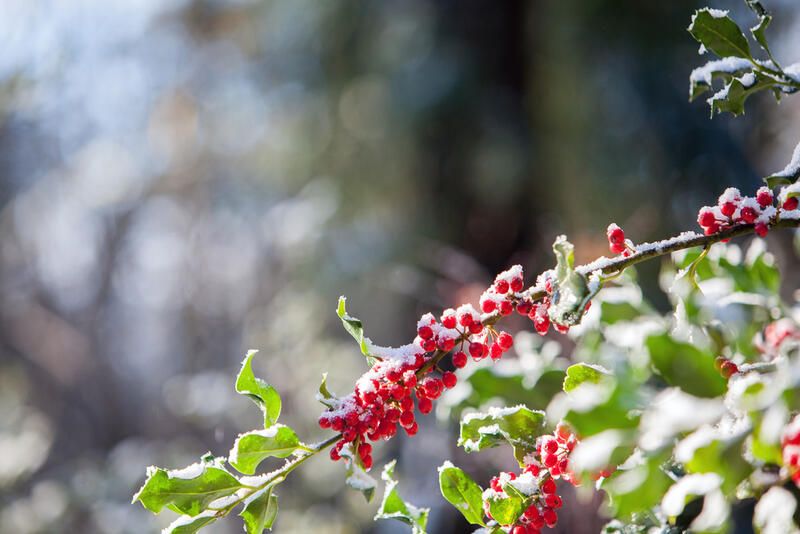
Japanese Holly 'Sky Pencil Holly'
Japanese holly's "Sky Pencil" variation is an unusual-looking evergreen type. The name itself gives it away; it develops into long, slender columns or plumes. Although it is smaller, the general shape is similar to a poplar tree. The behavior is unique and uncharacteristic for hollies.
The leaves are tiny, glossy, green, and spikeless. The berries then appear in the summer, mature, and turn black in the fall.
Grow Japanese Holly 'Sky Pencil' as a specimen plant or in compact clusters of spaced-out "pencils"; it is also excellent for wall side borders. It is appropriate for both casual and city gardens.
-
USDA Hardiness Zone: 6-8
-
Size: 6-10 ft. tall & 1-3 ft. spread
-
Sunlight: Full sun to partial shade
-
Soil: Loam, clay, chalk, or sand-based soils with good drainage and a pH range of mildly acidic to slightly alkaline. It can withstand drought.
-
Type: Small tree-like shrubs
English Holly (Ilex aquifolium)
When it comes to our genus of winter trees, the English holly is the classic of all classics! It comes in postcard form. It boasts glossy, hard-to-touch foliage with smooth top edges and prickly bottom edges.
Although some kinds have variegated leaves, the typical hue of the leaves is a rich, dark emerald green. For instance, the eye-catching 'Argentea' cultivar boasts purple stems and cream-yellow leaf margins! The Royal Horticultural Society has given "Argentea" its Award of Garden Merit. The conical-shaped trees have an upright habit by nature.
Given its huge size, you can use this evergreen species as a specimen tree or for foundation planting in your winter garden where the red berries will provide color.
-
USDA Hardiness Zone: 6-10
-
Size: 15 - 25 ft. tall & 10 ft. spread
-
Sunlight: Full sun to partial shade
-
Soil: well-drained soil (clay or chalk) with slightly acidic soil pH
-
Type: Tree
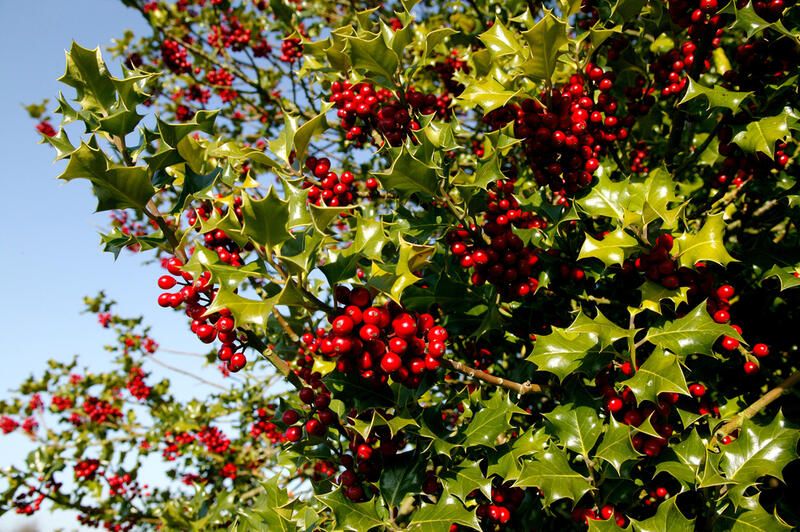
Japanese Holly (Ilex Crenata)
Evergreen Japanese holly is a highly unique kind. The leaves have wavy edges and are tiny, spherical, and lustrous. The plant can develop in many shapes and with various behaviors. It may grow thick and bushy or become a standing tree.
You can keep it small or give it any form you choose because it is incredibly simple to prune and train. The black (dark blue) berries start to appear in the summer and ripen in the fall.
Japanese holly is an excellent substitute for boxwood in foundation planting and fenced areas since it is more resilient.
-
USDA Hardiness Zone: 5-7
-
Size: 4-10 ft. tall
-
Sunlight: Full sun to partial shade
-
Soil: Loam, clay, chalk, or sand-based soils with good drainage and a pH range of mildly acidic to slightly alkaline. It resists drought.
-
Type: Can be trained as a shrub or tree
American Holly (Ilex opaca)
With dark green foliage, glossy teethed leaves, and clusters of crimson berries at the tips of the branches, the American holly is a highly lovely evergreen tree. It is particularly sculptural because of its tendency of standing quite straight and pyramidally.
The blooms are small, numerous, and both male and female. They bloom in the spring. The berries then start to appear in the summer and ripen in the autumn.
It is a great plant for urban parks or a sizable garden, even a stately one. Grow it as a specimen plant or as a foundation planting. It looks amazing in concentrated small groups.
-
USDA Hardiness Zone: 5-9
-
Size: 15-30 ft. tall & 10-20 ft. spread
-
Sunlight: Full sun to partial shade
-
Soil: Loam, clay, chalk, or sand with a pH range of mildly acidic to neutral, but with good drainage.
-
Type: Tree
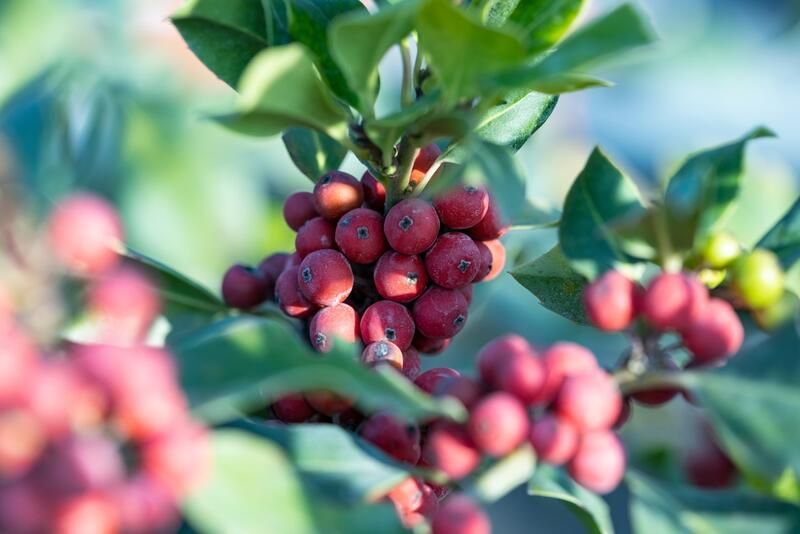
Inkberry Holly (Ilex Glabra 'Shamrock')
The cultivar "Shamrock" of the holly shrub type known as inkberry is one of the most well-liked holly tree varieties around.
It grows into rounded, dense shrubs with a compact shape and emerald green foliage. The leaves are round, and glossy, and lack teeth or spikes. They are also long.
The flowers are white and green and bloom in the summer. These are tiny but numerous, and they are followed by dark green and blue berries that, if the birds allow them, will endure through the winter.
Because it enjoys water and moist soil, Inkberry 'Shamrock' makes a unique holly yet works well in hedges and borders. Hence, it can be used in bog gardens, wet gardens, around ponds, and along streams and rivers.
-
USDA Hardiness Zone: 4-9
-
Size: 4 ft. tall & Spread
-
Sunlight: Full sun to partial shade
-
Soil: Soil made up of loam, clay loam, or clay with a pH range of 5.1 to neutral.
-
Type: Small Shrub
Chinese Holly (Ilex Cornuta)
Chinese holly is a beautiful but active type that is evergreen. The leaves are oval and have no spikes; they are a deep emerald, green color.
They feel like leather and are somewhat twisted. The little but incredibly fragrant white blooms bloom in the spring. The crimson berries will then appear and remain on the pyramidal of holly berries into the fall or even the winter.
This simple-to-grow evergreen cultivar can be allowed to develop into a bush or a tree.
Because of its adaptability, it can be used in coastal gardens as well as hedges, foundation planting, and specimen gardens.
-
USDA Hardiness Zone: 7-9
-
Size: 15 - 20 ft. tall & 20 ft. spread
-
Sunlight: Full sun to partial shade
-
Soil: well-drained loam soil (sandy) with mildly acidic to neutral soil pH
-
Type: Tree but can be kept as a shrub.
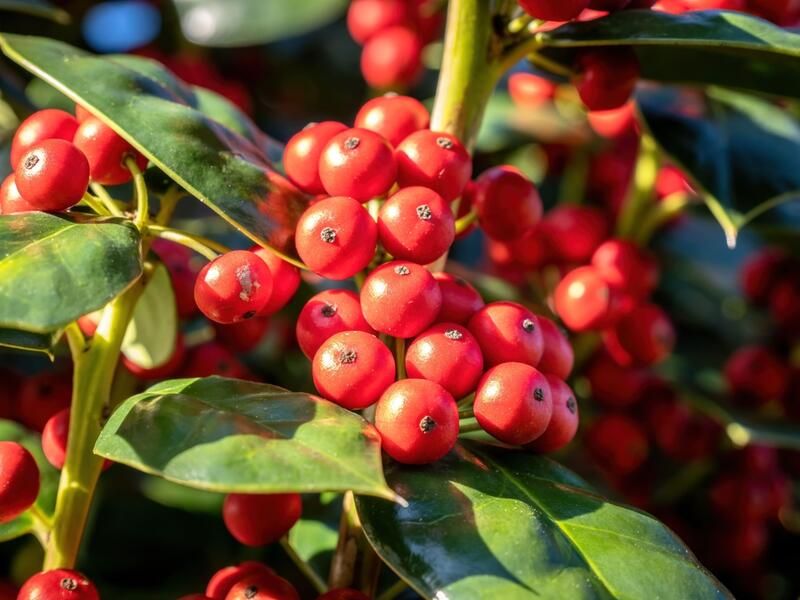
Japanese Holly 'Brass Buckle'
The Japanese holly variety known as "Brass Buckle" is an ever gold, not an evergreen. The tiny, oblong leaves are, in reality, a bright yellow color, and it stays this way all year long!
It is a little shrub with a rounded habit, and the color of its leaf is actually what sets it apart. It is more susceptible to pests like aphids and scale insects than other holly species.
This adorable little cultivar is small enough to be grown in containers and looks beautiful along the edges of pathways. Hence, you can either grow it on your patio to get some sunlight all year round or mix it in with other shrubs to add some colorful light to your borders.
-
USDA Hardiness Zone: 6-8
-
Size: 1-2 ft. tall & Spread
-
Sunlight: Full sun to partial shade
-
Soil: Loam, clay, chalk, or sand-based soils with good drainage and a pH range of mildly acidic to slightly alkaline. It resists drought.
-
Type: Small shrub
Yaupon (Ilex Vomitoria)
Yaoupon is another evergreen holly variety that can grow into a small to a medium-sized tree or a shrub. Its similarly dense, glossy, leathery foliage covers its extremely thick branches. The edges of the long, shallowly toothed leaves.
Summertime brings about an abundance of berries that are a vivid crimson color. Native People used to eat the twigs produce berries of this plant during ceremonies and subsequently throw them back up, hence the Latin name.
Whether you keep yaupon as a shrub or tree will affect how you use it. It works well as a shrub for topiary, hedges, and windbreaks, but you can also grow it as a tree in groups or as test specimens.
-
USDA Hardiness Zone: 7-9
-
Size: 10-20 ft. tall & 12 ft. spread
-
Sunlight: Full sun to partial shade
-
Soil: Loam, clay, chalk, or sand-based soils with good drainage and a pH range of mildly acidic to slightly alkaline. It can tolerate both dry soil and salty soil.
-
Type: Large Shrub/ Medium to Small Tree
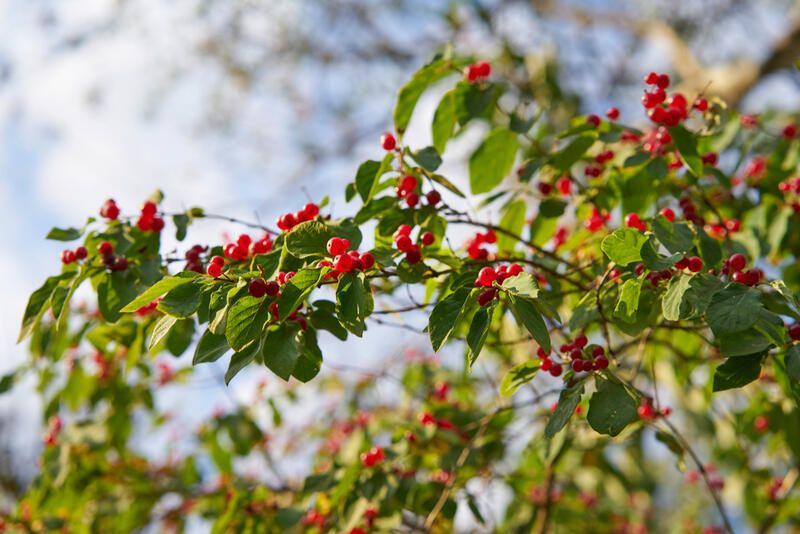
Deciduous Holly Plants
More well-known and widespread than the Ilex genus' deciduous trees and shrubs are its evergreen hollies.
Possumhaw and particularly winterberry are two prominent leaf-dropping plants that are very well-liked by gardeners.
Towards the end of the fall, these will lose their leaves, but they will preserve their colorful berries!
In contrast to what you get with evergreens, the impact is nevertheless dramatic. Just picture thick barren branches covered with a profusion of bright red berries throughout the winter.
So, should we examine them as well? These are them.
Winterberry Holly (Ilex Verticillata)
Winterberry turns into a spectacle despite being a deciduous holly shrub. The fact that fall-dropping elliptical, green leaves with serrated margins have a fragile appearance is not a drawback.
This holly species produces so many berries that the branches they grow on are hardly visible! Your winterberry will continue to bloom in the spring after these last all fall and winter.
There are various varieties, and they can all be identified by the color of the berries.
-
The berries on "Red Sprite" are scarlet red.
-
The berries on "Winter Gold" are orange.
-
The berries on "Berry Heavy Gold" are yellow.
It looks beautiful along rivers and by the side of ponds, and this variety will also thrive in damp and bog gardens! This Cary Award cold hardy Winner is great for borders and hedges!
-
USDA Hardiness Zone: 3-9
-
Size: 3-5 ft. tall & Spread
-
Sunlight: Full sun to partial shade
-
Soil: pH ranges from severely acidic (4.5) to neutral in loam or clay-based soil.
-
Type: Small Shrub
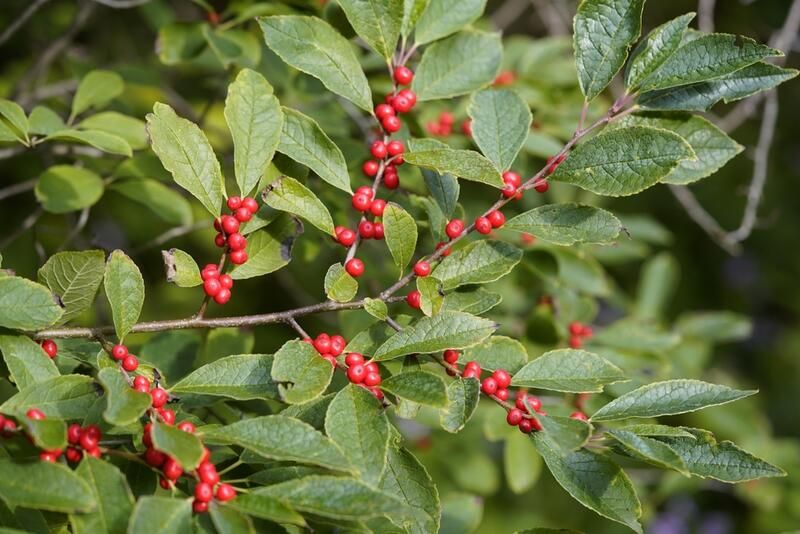
Possumhaw (Ilex Decidua)
Possumhaw's scientific name, which translates to "deciduous or holly bush," is used. The round, herbaceous, and fresh-looking leaves of this shrub species are more matte than shiny. They have a light green hue, and the edges of them are crenate.
They will eventually turn yellow and drop in the fall, exposing a cluster of vivid red berries on the plant's thin branches that will persist through the winter. There are also variations in pink, gold, and blue.
Possumhaw is a highly attractive shrub that can be grown in tall borders or hedges to keep them colorful over the winter. It will also adjust to the sides of ponds and streams.
-
USDA Hardiness Zone: 5-9
-
Size: 7-15 ft. tall & 5-12 ft. spread
-
Sunlight: Full sun to partial shade
-
Soil: pH levels ranging from moderately acidic to neutral in well-drained loam, clay, chalk, or sandy soil.
-
Type: Medium to Large Shrub
The Beauty of Holly Varieties
Holly bushes and trees are more than just a tiny branches with prickly leaves and scarlet berries to hang on your door during the holiday season.
Hollies make excellent garden plants. Few plants possess the characteristics that we find in the Ilex genus... Check out Shrubhub.com for even more ways you can use your holly bushes!
Conical and pyramidal forms, upright and straight trunks... You also receive gorgeous, glossy, and ornamental foliage, and many of them can withstand any kind of cutting and shaping...
Of course, there are also all those lovely berries!
And now that you are familiar with all of the most popular garden varieties, where to grow them, and how to utilize them, feel free to start selecting the one your patio or garden needs!


